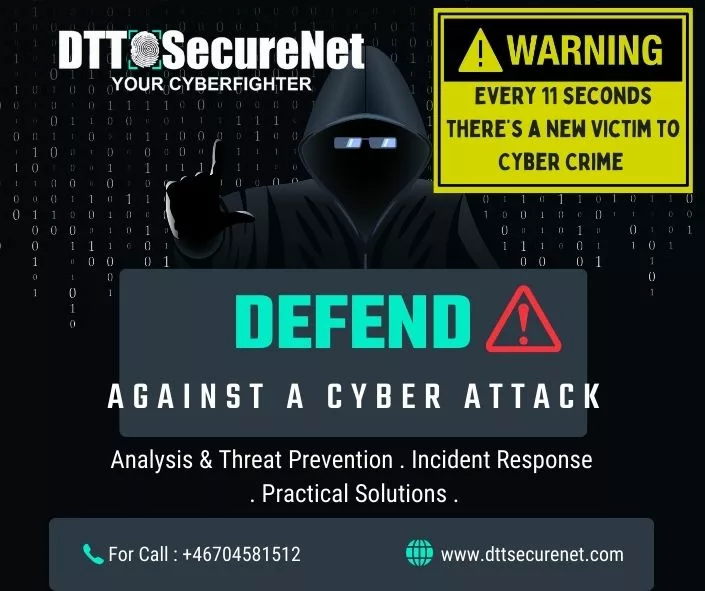How to Prevent Cyber Attacks
Learn how to prevent cyber attacks and the most common threats in 2023 and 2024

About
How to Prevent Cyber Attacks
Cyber attacks are most common that you may think. It is estimated that every 11 seconds, a new person or organization has fallen victim to cyber crime somwhere around the world.
There are many types cyber attacks, which require different precautions and each may be approach differently, however, for all of them, regardless of their different characteristics, the best approach is always education and awareness.
Let’s discuss further how to prevent a cyber attack and the different types as well as how we can protect ourselves better.

1) Virus or Malware
There are many different types of malware or computer virus that have different end-goals. Some will have a goal of destruction. These are called Destructive Virus and once executed, will start deleting files, drives and important data that will likely not be possible to be recovered again. This destruction will continue until either stopped by a professional or until the device is non-operational anymore, thus stop working entirely.
How to prevent this type of virus or malware?
A) Don’t open or download files that are uknown to you or that you cannot recognize.
B) Don’t open emails that look physhy or from suspicious sources.
C) If you receive an email or message from one of your contacts but the content of the email looks suspicious, try to contact this person directly and ask if he or she was the real sender. Yes, it is extremly easy to fake an email or message from a known contact of a target. You would be surprised.
D) Always have a good AntiVirus installed in all your devices and updated. If you want to know which AntiVirus we recommend feel free to read more HERE about them.
E) Don’t navigate over strange or suspicious websites or web-pages. It is possible to embed an executable virus or malicious code on a specific webpage and this one is executed once you browse even without downloading anything or clicking on anything. This methodology is referred to “Cross Site Scripting or XSS”.
2) Network Attacks/WiFi Hijack
Network attacks are another way to attack a target or victim.
On this instance, the hacker infiltrates your network and from there he will try then to get inside your computer and take total control of it. These type of attacks are extremly dangerous since the attacker will first be able to see all your inputs and actions from where he or she will try to get your passwords or sensitive information for the second step which will be a login and take control of your computer and information. This type of attack has goals like identity thef, stealing of credit cards, account hijack among others.
One of the methodologies used for this type of attack is called “Man in the Middle” or MITM. The attacker will position between your computer and your server tricking the server and your computer and listening for any inputs and actions requested by the you or the victim.
Ok! how do we prevent this? The easiest is to be aware that this can happen and use only secure networks.
Secondly, make sure that your router at home or the office is set to WPA2 and not under WEP which is very insecure.
Another way to secure yourself is to use a reputable VPN. VPN ensures that all requests made by you to your server are encrypted and not possible to see by third parties. If you’d like to know which VPN services we recommend click HERE.
The last but not least is to pay attention to the URL where you navigate. Make sure the web-page is with the padlock (on HTTPS protocol) and not HTTP. The difference with these two is that HTTP does not encrypt your requests and consequently if a third person is listening to your requests, he or she will be able to see every password and input you do on your computer.
Relevant to HTTPS, make sure that your most common sites are genuine with HTTPS and not with an alternative URL like .CORN or anything that shouldn’t be.
Stay attentive to your browsing!
3) Physhing Attacks
A physhing attempt and attack is when the hacker or cyber criminal canot access your computer or systems directly, then consequently they will attempt to trick you and make you believe of a situation that is not real. This will attempt to retrieve passwords, make money transfers or other unwanted scenarios.
When it comes to physhing, there are no real ways to prevent it other than to be aware of what can and cannot be real. Look at the URLs you navigate, don’t give passwords over the phone or messangers. Don’t provide sensitive information to anyone requesting such information. Banks and other institutions won’t ask you for such info. They can easily see everything on their systems.
Do not fall for scams. Always double check directly with the real source. For example, if somone claims is from your bank and asks you for sensitive information, hung up and call the bank directly to corroborate. If a person claims is for a governmental office, then contact that specific office before giving away money or sensitive info.
Another way to counter physhing attempts and to be extra safe is to use an external physical 2-factor password key or Yubikey. A Yubikey is the most efficient until now and most secure to stay safe. This physical key is inserted physically to your device to access private accounts and lets anyone without the physical key unable to do so even if they convience you to give them access.
See more about YubiKeys HERE and feel free to contact me if you wish to buy one for yourself.
Another way to defend yourself and be more secure is to use an Authenticator App in which in order to access your accounts your need to write a code that changes every 1 minute. This way is secure although a little less than the YubiKey; nonetheless, a very good practice to use one.
4) Password Cracking
Cracking passwords is not complicated but when using a strong one, it will demand resources from an attacker and thus, maybe demotivating from trying to attack through this option.
There are a few ways to crack a password and different ways to protect against it. The best suggestion we can offer it’s to use strong passwords and different for all your accounts! The worse that one can do is to use simple passwords and default passwords that can be easily found online.
One of the techniques to crack passwords is by “Brute Force” in which you have a wordlist of all possible combinations and throw to the system all possibilities until the password is found. A simple password will take a relatively small wordlist and a few seconds to crack while a complex password made out of special characters, numbers and letters will demand a big wordlist and a lot of disc-space to host, then, the time for cracking such password can be very long from hours to weeks depending on how complex this password is. For this reason, having a complex password will likely make the attacker try a different method unless he or she cannot find any other possible way and he or she badly wants to attack you specifically; otherwise, it would be better to seek for a more vulnerable victim.
For this scenario we recommend using a password manager! They’re userfriendly, incredibly effective and very secure. Read more about them HERE.
Send me an inquiry to the following email: [email protected]
*Note that when you send me an email, I may keep your information to reply for a relevant request and for marketing purposes relevant to your interests. This is done according to our Privacy Policy and in accordance with the GDPR.

Final Notes about How to Prevent A Cyber Attack
What we mentioned on this article is only the tip of the iceberg and there are many ways for intruders or cyber attackers or more commonly known as Hackers to hack a system and take over information, steal data and destroy files, etc.
It is impossible to prevent or counter act a cyber attack to 100%, however, we can make ourselves and our systems more secure and divert an attacker or making their attempts difficult.
Now you know better how to prevent cyber attacks.
If you’re concerned about your online security or the security of your business or organization, feel free to write me to book a consultation.
Send me an inquiry to the following email: [email protected]
*Note that when you send me an email, I may retain your information for marketing purposes and/or to contact you back regarding a relevant request. This is conducted according to our Privacy Policy and to GDPR rules.
